While most Lincoln wheat pennies have only modest value today, a few well-preserved examples—especially those with bright red color and rare errors—can still sell for impressive sums at auctions.
The value of a 1928 wheat penny depends on several factors:
- Color (Brown [BN], Red-Brown [RB], or Red [RD])
- Luster and surface appeal
- Mint mark
- Overall condition
- Presence of any mint errors
In general, only the best-preserved red specimens, particularly those with errors, can bring significant prices, despite the penny’s low face value.
1928 Wheat Penny Value Chart (Brown Coins)
| Condition | 1928 (No Mint Mark) | 1928-D | 1928-S |
|---|---|---|---|
| Good | $1 | $1 | $2 |
| Very Good | $1 | $1 | $3 |
| Fine | $1 | $2 | $5 |
| Very Fine | $3 | $8 | $15 |
| Extra Fine | $3 | $14 | $20 |
| About Uncirculated (AU) | $5 | $22 | $34 |
| Mint State 60 (MS60) | $14 | $42 | $120 |
| Mint State 63 (MS63) | $26 | $65 | $225 |
🟤 Note: These values apply to coins with a brown (BN) designation. Red (RD) coins in similar grades can be worth significantly more.
If you happen to own a 1928 wheat penny in excellent condition—especially with a Denver (D) or San Francisco (S) mint mark and full red luster—it could be well worth a closer look or even a professional appraisal.
History of the 1928 Wheat Penny

The U.S. Mint first issued Lincoln Wheat pennies in 1909. This was done at the request of President Theodore Roosevelt, who asked Victor D. Brenner to design the coin to commemorate the 100th anniversary of Abraham Lincoln’s birth.
1928 Wheat Penny Types
The production of 1928 wheat pennies included the following mint facilities:
| Location | Year | Minted |
|---|---|---|
| Philadelphia | 1928 No Mint Mark | 134,116,000 |
| Denver | 1928 D | 31,170,000 |
| San Francisco | 1928 S | 17,266,000 |
| Total | / | 182,552,000 |
The first Lincoln Wheat pennies featured Victor Brenner’s initials (VDB) between the wheat stalks on the reverse side. However, the public felt the initials were too prominent, so they were removed from the design. The coins were issued without the initials until 1918, when they were reinstated after the controversy had died down.
Features of the 1928 Wheat Penny
The 1928 pennies featuring the wheat stalks on the reverse were designed based on Victor Brenner’s creative vision. These coins were part of the ongoing Lincoln Wheat penny series, which featured Brenner’s initials (VDB) on the reverse.
Unlike the earlier issues from the first decade of production, most of the 1928 pennies included Brenner’s initials in the design. However, this design element faced public backlash, leading to its removal shortly after. Let’s explore this in more detail.
The obverse of the 1928 Wheat Penny
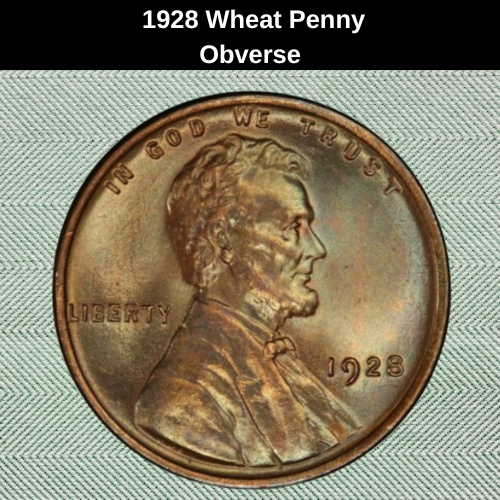
Victor Brenner designed the obverse of the 1928 Wheat Penny, featuring a portrait of Abraham Lincoln facing right. This simple yet iconic design placed Lincoln’s image at the center of the coin, with the word LIBERTY to the left and the date to the right of the bust.
Coins minted in 1928 were part of the series that included Brenner’s initials (VDB), which were added in 1918 following the controversy surrounding the initials on the 1909 coins. Above Lincoln’s portrait is the famous motto: IN GOD WE TRUST, which runs along the top edge of the coin.
Coins minted at the Philadelphia Mint during this period did not feature a mint mark. However, coins from the Denver (D) and San Francisco (S) mints can be identified by their respective mint marks, which are struck just below the date.
The reverse of the 1928 Wheat Penny
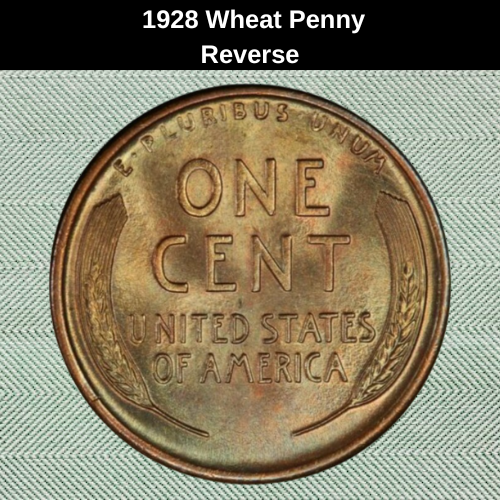
The reverse of the 1928 wheat penny primarily features inscriptions, including:
- E PLURIBUS UNUM
- ONE CENT
- UNITED STATES OF AMERICA
The coin’s most distinctive feature is the two ears of wheat that stretch along the right and left rims, which gave the coin its famous nickname—Wheat Penny.
Although the original design intention by Victor Brenner was different, it was ultimately changed, and the current version with the wheat stalks became the finalized design.
1928 Wheat Penny Details
- Shape: Round
- Material: An alloy of 95% copper with zinc or tin
- Thickness: 1.52 mm (0.0598 inches)
- Face Value: One cent ($0.01)
- Diameter: 19.05 mm (0.75 inches)
- Edge: Plain
- Weight: 3.11 g (0.10970 ounces)
Other Features of the 1928 Wheat Penny
The 1928 wheat pennies minted in all three facilities (Philadelphia, Denver, and San Francisco) are one-cent coins made of 95% copper. The thickness of these coins is 1.52 mm (0.0598 inches), and they have a diameter of 19.05 mm (0.75 inches), which are standard for this type of coin. Each penny weighs exactly 3.11 g (0.10970 ounces) and features a plain edge.
1928 Wheat Penny Grading Guides
1928 wheat pennies are nearly a century old, so it’s no surprise to find them in a wide range of conditions. Some are so worn that they hold little to no value for collectors. However, rare, well-preserved examples—especially those without flaws—are highly sought after.
The role of professional graders is to carefully evaluate each coin, focusing on condition, color, and grade. Once graded, they also check for errors, which can significantly increase the coin’s value. After completing this process, they assign a price range based on the coin’s characteristics.
Here’s a simplified breakdown of the grading scale used:
| # | Grade |
|---|---|
| 1 | Basal State-1 |
| 2 | Fair |
| 3 | Very Fair |
| 4–6 | Good |
| 7–10 | Very Good |
| 12–15 | Fine |
| 20–30 | Very Fine |
| 40 | Extremely Fine |
| 50 | About Uncirculated |
| 60 | Mint State |
| 65 | Mint State |
| 70 | Mint State (Perfect) |
🔍 Tip: Be sure to consult a professional or a detailed coin grading guide to properly assess your 1928 penny. This is a crucial step in determining its actual value!
1928 Wheat Penny Value Guides
A total of 182,552,000 wheat pennies were struck in 1928 across three US Mint facilities: Philadelphia, Denver, and San Francisco.
All of these coins were regular strikes, as the US Mint did not produce proof coins for collectors between 1917 and 1935. This makes any well-preserved or error coins from 1928 particularly valuable to collectors today.
🪙 Fun Fact: Even though these were mass-produced coins, certain specimens in Mint State condition—or with notable errors—can be worth hundreds or even thousands of dollars!
1928 No Mint Mark Wheat Penny Value
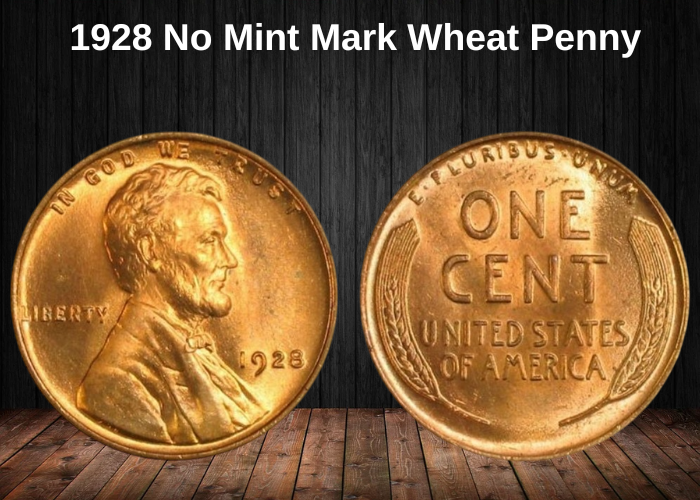
With 134,116,000 pennies minted, the Philadelphia Mint had by far the highest output in 1928. As a result, many of these coins are common and affordable, especially in circulated condition.
- Most brown-colored coins range from $1 to $75, depending on their grade. 🏆 Exception: A 1928 brown penny graded F12 sold at a 2007 auction for $1,035.
- Uncirculated pieces naturally command higher values, but even top-grade examples rarely exceed $75 in brown.
- Red-brown coins tend to be priced between $24 and $185, based on their condition.
- Red specimens are the most valuable:
- Average prices fall between $50 and $550.
- An MS67 red penny can cost up to $1,300.
- 💰 One of the rarest MS67+ red coins sold for a staggering $9,000 in 2019.
📌 Tip: Color, grade, and mint luster significantly affect a coin’s value—especially for common dates like 1928.
1928 D Wheat Penny Value
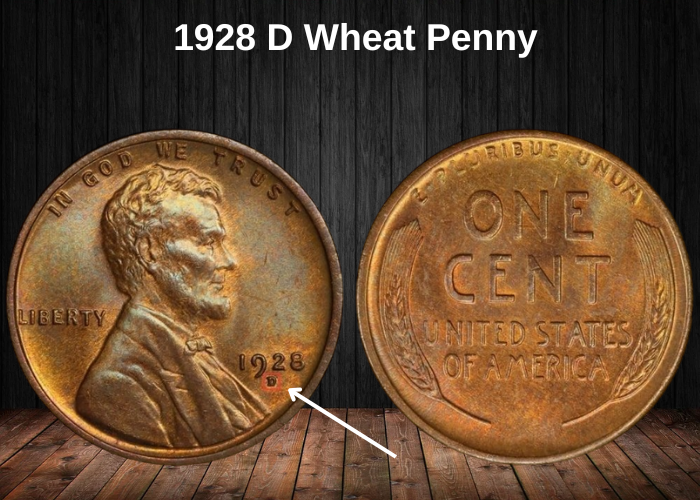
The Denver Mint had the second-highest penny mintage in 1928, producing 31,170,000 coins. While substantial, this number was much lower than Philadelphia’s, and the prices of surviving pieces reflect that difference.
- You’ll need about $1 to $22 to buy a circulated brown coin.
- Mint State (uncirculated) examples range from $42 to $250. 💎 Well-preserved pieces graded MS66 are valued at around $650.
The red-brown (RB) 1928 D pennies are pricier, as expected:
- They typically sell for $50 to $500 on the open market.
- A MS66RB coin sold for $686 in 2020.
For serious collectors, red (RD) 1928 D pennies are the top-tier option, and their prices increase significantly with grade:
- $100 for an MS62
- $175 for an MS63
- $325 for an MS64
- $1,450 for an MS65
- $11,000 for an MS66
- $62,000 for an MS66+
🏆 Record Sale: The second most expensive regular 1928 penny is a 1928 D red MS66, which fetched $12,600 at auction in 2022.
In contrast, a similar MS66+ brown penny sold for $1,125 on eBay in 2020.
1928 S Wheat Penny Value
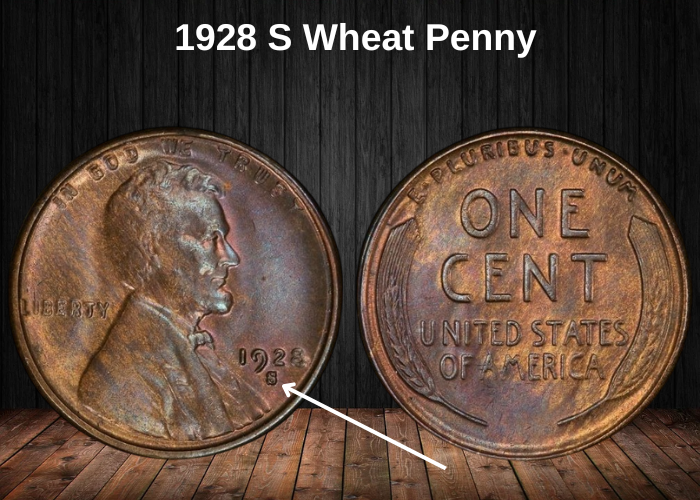
As was typical, the San Francisco Mint had the lowest production of Lincoln wheat pennies in 1928, releasing only 17,266,000 coins. This lower mintage contributes to their relative rarity, especially in higher grades—coins graded above MS65 are practically impossible to find.
- Circulated brown pennies (used in everyday transactions) usually range from $1 to $45.
- Uncirculated brown examples (MS60 to MS65) sell for $120 to $650, depending on quality.
Red-brown (RB) 1928 S pennies are significantly more valuable:
- Prices range from $170 (MS62) to $1,850 (MS65).
- A record sale in 2008 saw an MS65 RB coin fetch $2,070 at auction.
But the real standout is the red (RD) variety:
🏆 Record Sale: The most expensive 1928 penny ever sold is a 1928 S red coin graded MS66.
It reached an incredible $45,600 at auction in 2020.
This makes the 1928 S MS66RD the top-value piece among all 1928 wheat pennies.
Rare 1928 Wheat Penny Errors List
The San Francisco Mint was responsible for producing more error pennies in 1928 than both the Philadelphia and Denver mints combined. While many of these flawed coins are not overly valuable, certain examples can be worth a premium, depending on two key factors:
- The grade (condition) – Higher-grade coins are more valuable.
- The visibility of the error – The more dramatic and recognizable the error, the higher the price.
Off-Center Error
One of the more common errors among 1928 wheat pennies is the off-center strike. These occur when the coin blank is misaligned during the strike, causing part of the design to be missing.
- Minor off-center errors (under 5%) are relatively common and may not fetch high prices.
- Moderate off-center errors (10–20%) are more desirable and can be worth around $100.
- Major off-center errors (50% or more) are quite rare and can exceed $250 in value, especially in higher grades.
BIE

Some 1928 wheat pennies feature a tiny vertical line between the letters B and E in the word LIBERTY. This line is caused by a die crack, which happens when the die used to strike the coin becomes worn or fractured.
This particular die crack is subtle but recognizable to collectors. If you’re interested in acquiring one of these pieces, you can expect to pay between $5 and $20, depending on the coin’s overall condition.
1928 Pennies Without “VDB” Initials
Most regular 1928 wheat pennies feature the artist Victor D. Brenner’s initials (VDB) beneath Lincoln’s shoulder. However, these initials can often become worn away on heavily circulated coins, making them hard or impossible to see — and in that case, the coin holds little to no added value.
That said, there are rare cases where the VDB initials are completely missing due to a strikethrough error caused by grease build-up on the die. In these cases, the initials were never properly struck on the coin in the first place. These error coins typically sell for $10 to $15, depending on their condition.
The large mint mark (Large S)
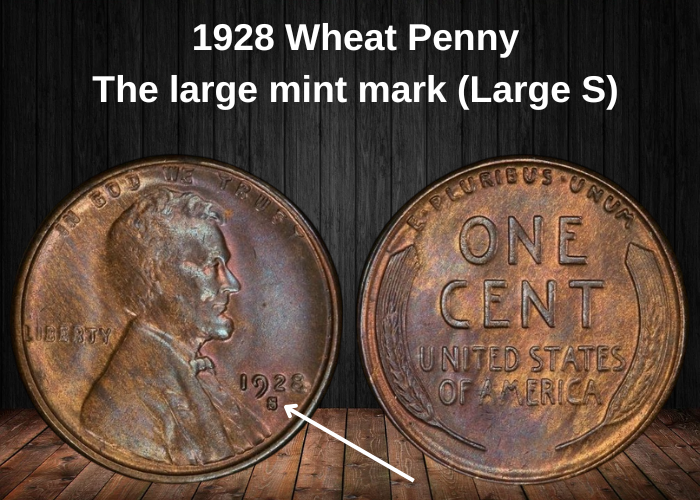
The 1928 wheat pennies minted in San Francisco are notable for a rare variety known as the “Large S” mint mark error. These coins feature an unusually oversized “S” beneath the date on the obverse. Experts believe that only about 100 examples of this variety exist in mint state condition.
While most of these coins typically sell for between $50 and $400, higher-grade examples can fetch significantly more:
- A brown MS64 Large S penny sold for $588 in 2012.
- A red-brown MS65 example reached $2,400 at auction in 2017.
- The current auction record goes to a red MS65 specimen, which sold for $5,875 in 2019.
Re-punched Mint Mark Error
In 1928, the San Francisco Mint produced a number of re-punched “S” mint mark pennies. Despite their relative abundance, these coins can still fetch between $20 and $100 depending on their condition and visibility of the error.
Doubled Die Error
Doubled die pennies, which were struck with a die that was impressed twice, are particularly collectible. For the 1928 wheat pennies, the errors are most noticeable in the motto, though they are typically minor. These coins typically range in price from $5 to $20 based on their condition.
Where to sell your penny?
Now that you know the value of your penny, you might be wondering where to sell it. Don’t worry: here’s a guide to some of the best online platforms where you can easily sell your coins, along with their advantages and disadvantages.
Discover the best platforms for selling coins online (pros and cons).
FAQ about the 1928 Wheat Penny
1. Why is the 1928 Wheat Penny considered one of the more common dates in the Wheat Cent series?
The 1928 Wheat Penny had a high mintage of 164,610,000 coins, especially from the Philadelphia Mint, making it one of the more commonly found dates in the series. As a result, it’s less rare compared to other years in the Wheat Cent series, which often leads to lower premiums for the more commonly found examples.
2. What distinguishes the 1928-S Wheat Penny from the Philadelphia and Denver issues in terms of value and collectibility?
The 1928-S has a significantly lower mintage of just 2,180,000, making it rarer than the Philadelphia and Denver-minted coins. Because of its limited availability, the 1928-S is sought after by advanced collectors, and coins in higher grades, especially uncirculated examples, can command a much higher price than their more common counterparts.
3. How does the condition of a 1928 Wheat Penny affect its desirability in the market?
Condition plays a critical role in determining the value of the 1928 Wheat Penny. While the coin is common in lower grades, a well-preserved 1928-S with red (RD) or extremely fine (XF) condition can demand a significant premium. Uncirculated MS64 or MS65 examples, particularly of the 1928-S, are highly valued due to their rarity and visual appeal.
4. What are the key design features of the 1928 Wheat Penny, and why do they hold historical significance?
The 1928 Wheat Penny is part of the Lincoln Cent series and features Abraham Lincoln’s portrait on the obverse, designed by Victor David Brenner. The reverse depicts two ears of wheat, symbolizing the agricultural foundation of the U.S. economy during the 20th century. The design ties the coin closely to America’s agricultural history, making it an important part of numismatic heritage.
5. Are there any notable varieties or errors that collectors should look for in the 1928 Wheat Penny series?
While the 1928 Wheat Penny series doesn’t have major widespread error types, die cracks, off-center strikes, and overlapping or doubled die errors occasionally appear. These anomalies are not particularly common, but when found, they can make the coin more valuable to collectors interested in rare varieties.
6. How did the economic conditions in 1928 affect the production and distribution of the Wheat Penny?
1928 was a year of economic prosperity in the United States, with the country enjoying a period of growth just before the Great Depression hit in 1929. The strong economy led to high minting numbers of coins, including the Wheat Penny. The stability of the coin’s design and large production numbers meant it was in widespread circulation, further ensuring the coin’s accessibility but limiting its rarity.
7. What are the long-term investment prospects for a 1928 Wheat Penny, and which variety is most likely to appreciate in value over time?
While the 1928 Wheat Penny is generally not considered an investment powerhouse due to its commonality, the 1928-S holds the most promise for future appreciation. Due to its low mintage and scarcity, especially in higher grades, it is more likely to see value growth over time. Coins in MS64 or higher with original red luster or those with significant errors may also see gradual price increases as demand for high-quality early Lincoln cents grows.



















































